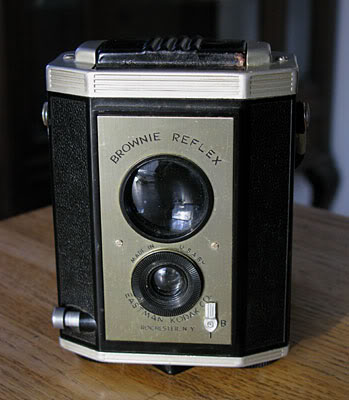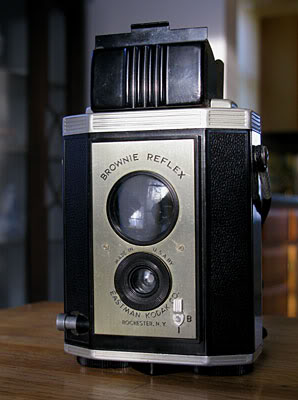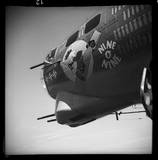vintage cameras index home

Designer: Henry O. Drotning

Kodak Ad, Popular Science, July 1940
 The elegant little Brownie Reflex was produced from 1940 to 1941. Kodak then added a capability to use flash in the succeeding "Synchro" model; that became one of the company's longest lived cameras, being produced in Great Britain until 1960. The camera's compactness was owed to its use of the 4cm-square 127 roll film format. The unique style is attributable in part to the fact that the inventor, Henry O. Drotning, came to Kodak with a background in designing mechanical music toys. Drotning filed his patent for the Brownie Reflex early in 1940, making it one the early roll film designs featuring a large and brilliant reflective viewfinder which would become very prevalent in the post-war years. (The British Ensign Ful-Vue came along slightly earlier in 1939, but the first was probably the Voigtl�nder Brillant in 1932.)
The elegant little Brownie Reflex was produced from 1940 to 1941. Kodak then added a capability to use flash in the succeeding "Synchro" model; that became one of the company's longest lived cameras, being produced in Great Britain until 1960. The camera's compactness was owed to its use of the 4cm-square 127 roll film format. The unique style is attributable in part to the fact that the inventor, Henry O. Drotning, came to Kodak with a background in designing mechanical music toys. Drotning filed his patent for the Brownie Reflex early in 1940, making it one the early roll film designs featuring a large and brilliant reflective viewfinder which would become very prevalent in the post-war years. (The British Ensign Ful-Vue came along slightly earlier in 1939, but the first was probably the Voigtl�nder Brillant in 1932.)
The non-flash model of the Brownie Reflex is uncommon. I was pleased to find myself on ebay as the only bidder on one, and I got it for just five dollars. The camera's exterior had only small blemishes from use. Inside, however, I discovered that the bakelite film carrier had broken away from the base. Someone, many years previously, had repaired the damage quite carefully with glue and cellophane tape. However, the tape and glue were yellow and brittle, and no longer held the parts together. I cleaned up the break, glued the parts together and added a bead of JB Weld all around the seam. Dismantling the camera was uncomplicated and enabled cleaning of the optics and the simple shutter.

The repairs seemed to get the camera working very well. I see there is a small intermittent light leak in one corner, indicating that I should have replaced the yarn light seals around the viewing chamber. A bit of flare doesn't really detract from the images, however, and I couldn't be more pleased with the results. I was able to get a couple rolls of Efke 100 in 127 format from B&H Photovideo which seems to be of good quality. I may try re-using the backing paper with some strips of 35mm film.
Butkus has a copy of the manual.

Below:a roll of images from my camera.

|

|

|

|

|

|

|

|

|

|

|

|
vintage cameras index home
 © mike connealy
© mike connealy